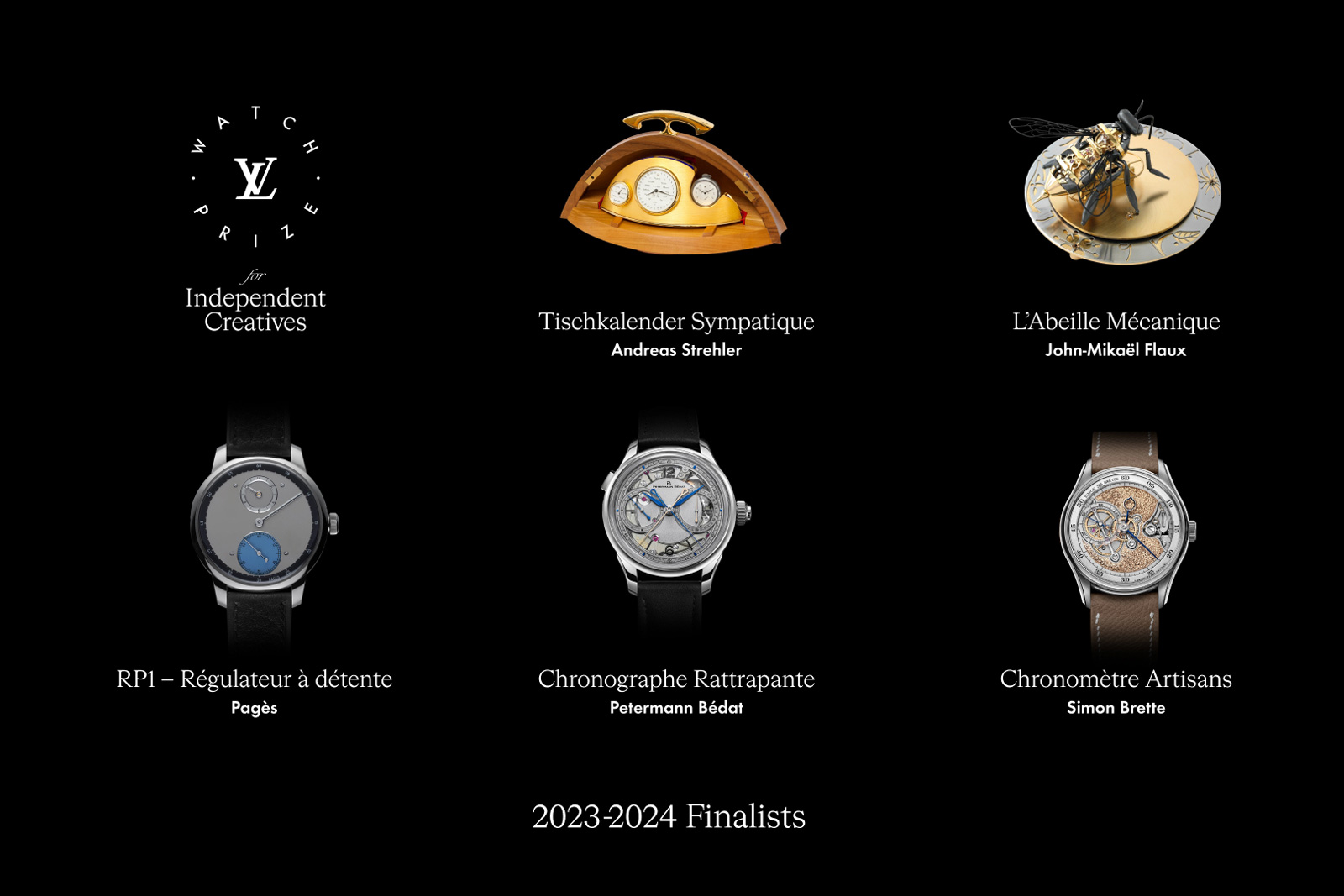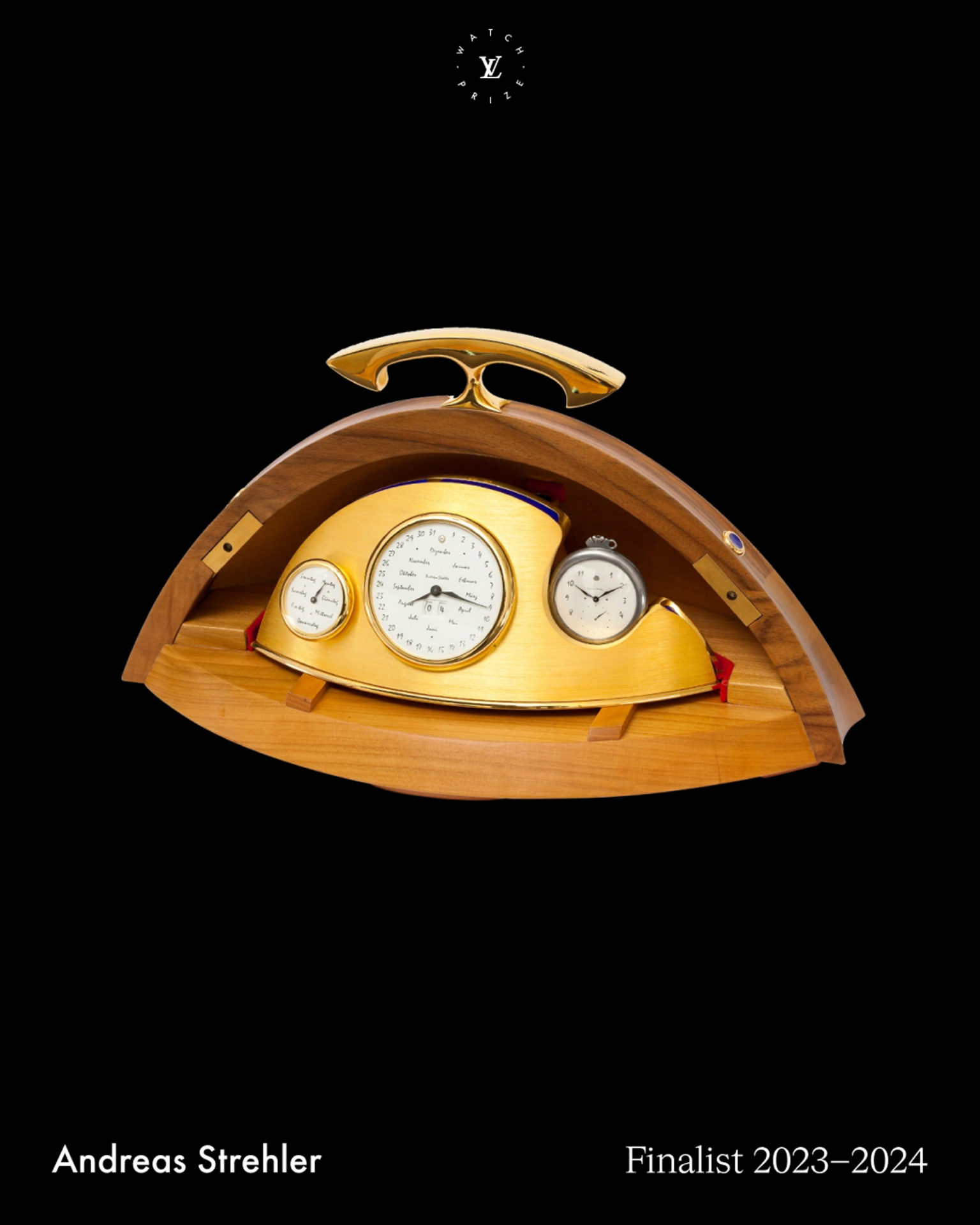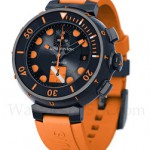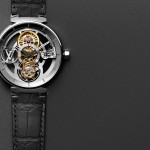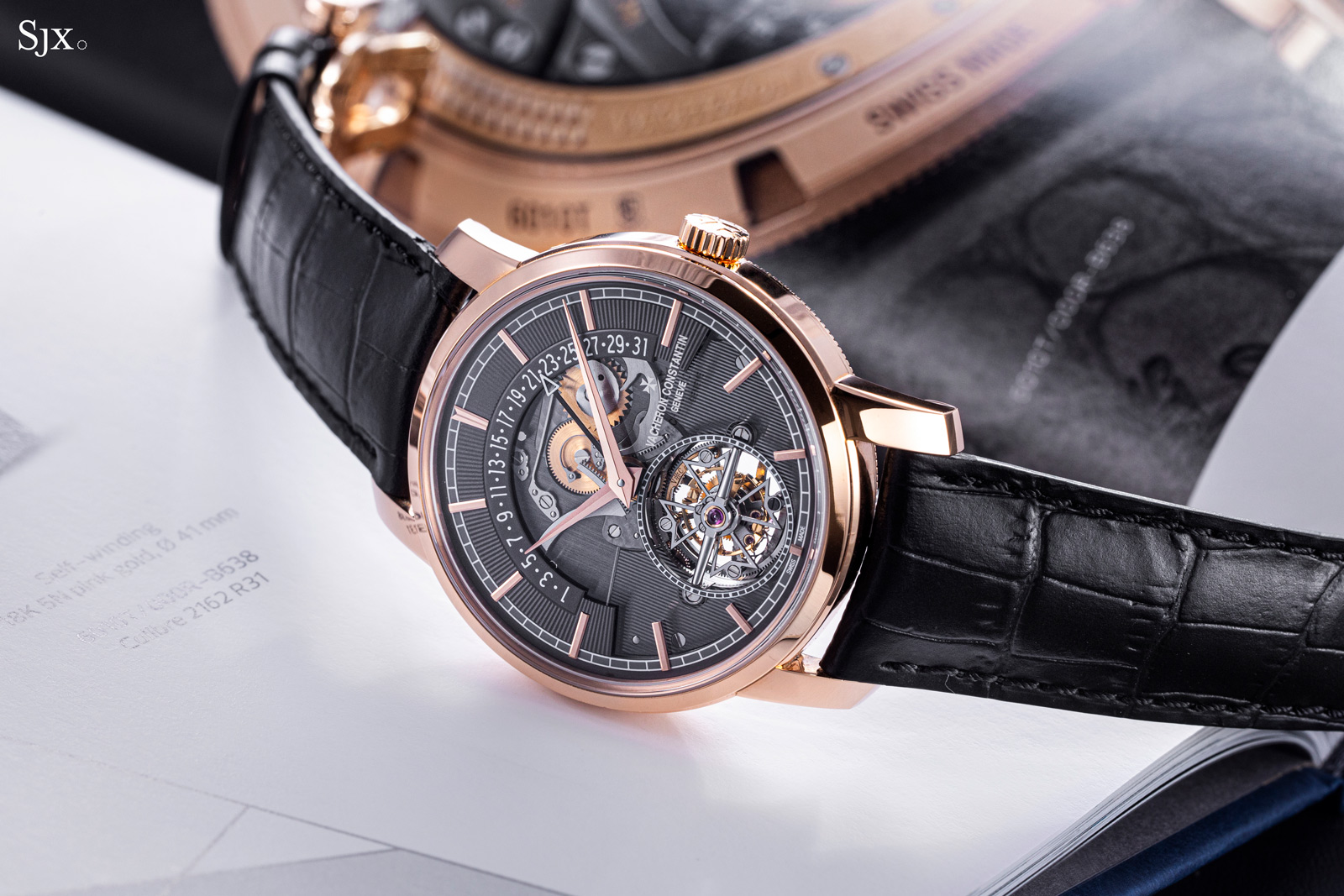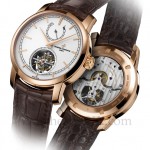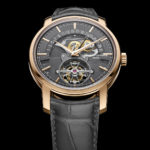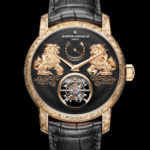Unveiled earlier this year as part of its retrograde-theme collection, the Vacheron Constantin Traditionnelle Tourbillon Retrograde Date Openface is self explanatory: it combines a tourbillon, retrograde date, along with a self-winding movement. And in contrast to many date indications that are almost an afterthought, this presents the date in an elaborate, thoughtful manner.
A clear sapphire dial shows off the retrograde mechanism, along with the base plate of the movement that’s been decorated with linear guilloche. And at six o’clock sits the tourbillon, with the cage in the Maltese cross emblem of Vacheron Constantin (VC), secured by a traditional bridge of polished steel.
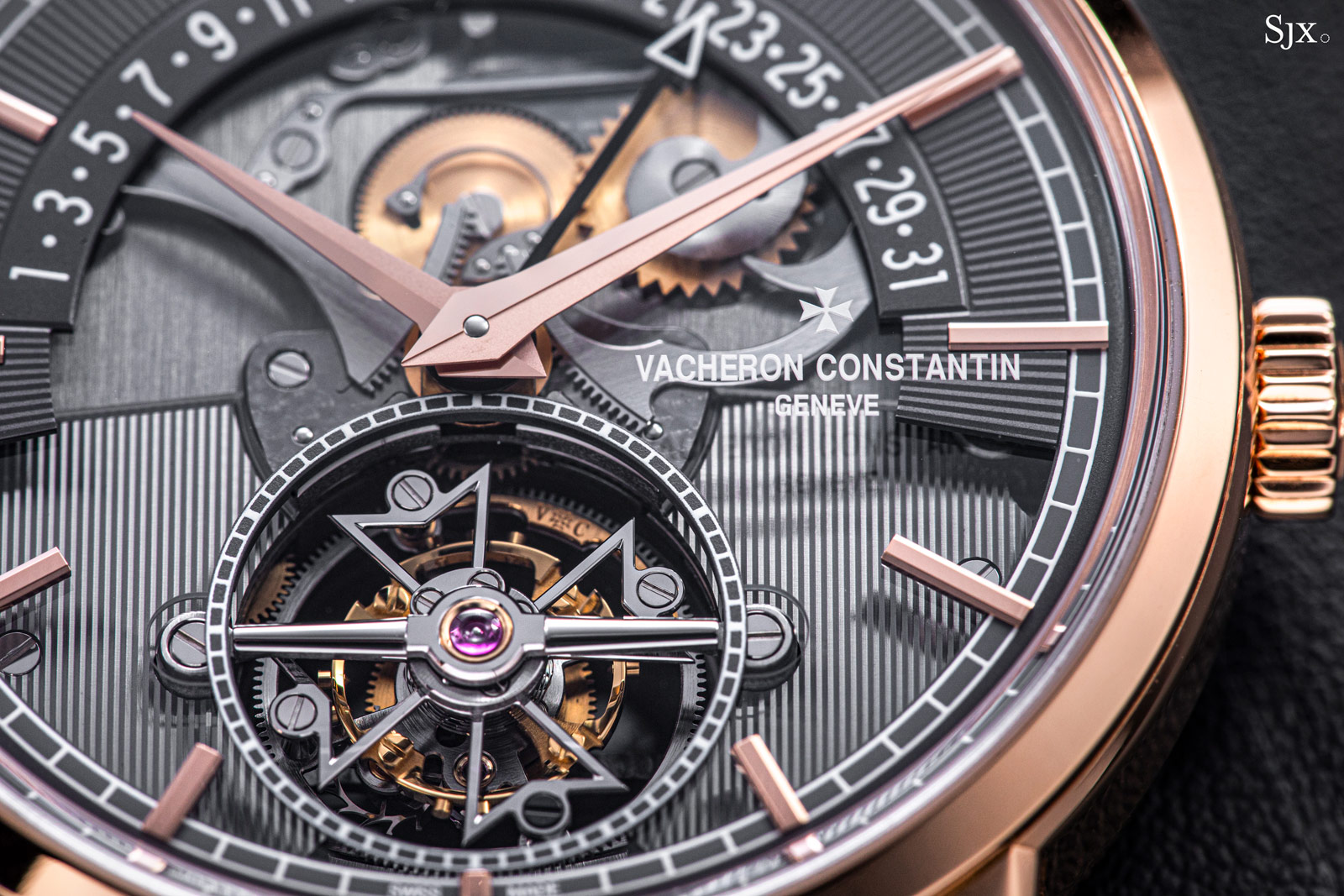
Initial thoughts
Classically-styled watches sometimes suffer from the addition of a date display; dates often get in the way of the design or just don’t fit in.
The Tourbillon Retrograde Date, in contrast, benefits from it. While the tourbillon might be the headline feature of the watch, and the peripheral winding the most novel, the retrograde date is the most appealing mechanical detail.
Retrograde displays are amongst the most striking dial-side complications because they are composed of parts in varying shapes, which allows them to be both beautiful and intricate when executed correctly, and here the date certainly is.
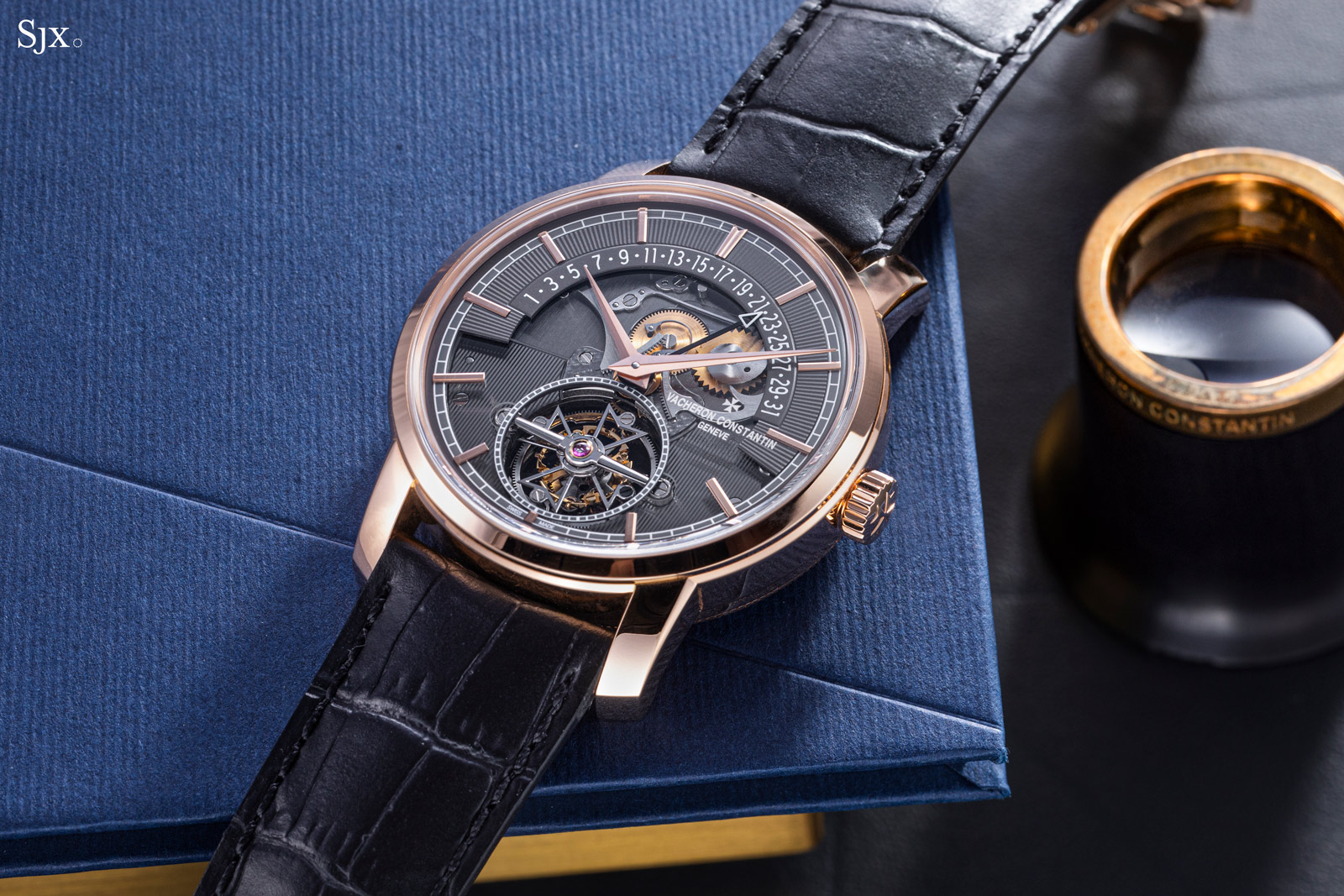
Despite being a simple function in itself, the date is executed well – it is finely constructed and finished. The components of the retrograde display are clearly designed to be seen as each is artfully shaped and large enough to be visible, yet endowed with attractive details.
The racks, springs, and snail of the retrograde mechanism are a counterpoint to the purely decorative aspects of the face, most notably the linear guilloche and the Maltese cross cage. Everything on the front is notably well finished, in particular the steel tourbillon cage with its sharp angles. The finishing on the back is almost as good, but without the decorative flourishes found on the face.
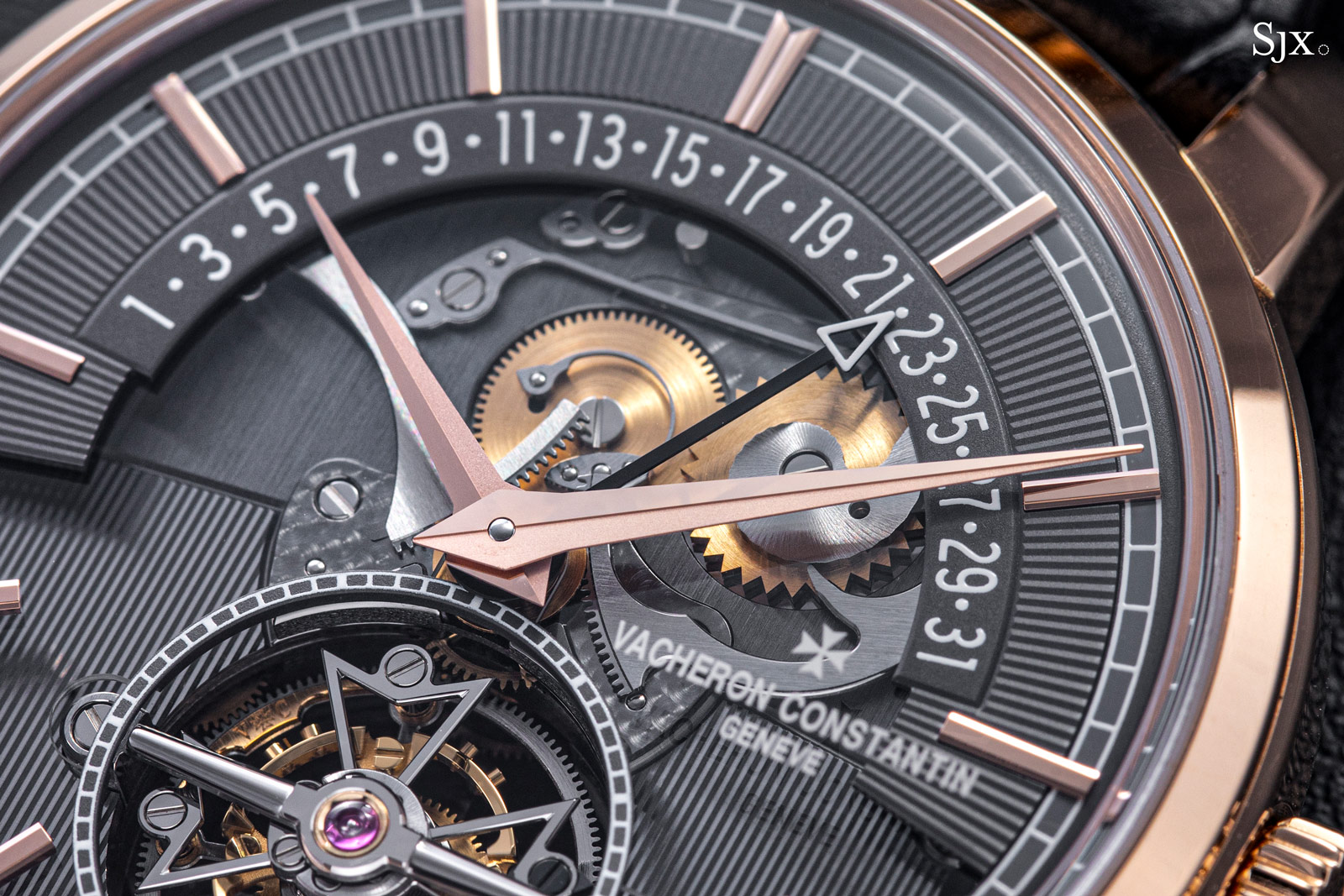
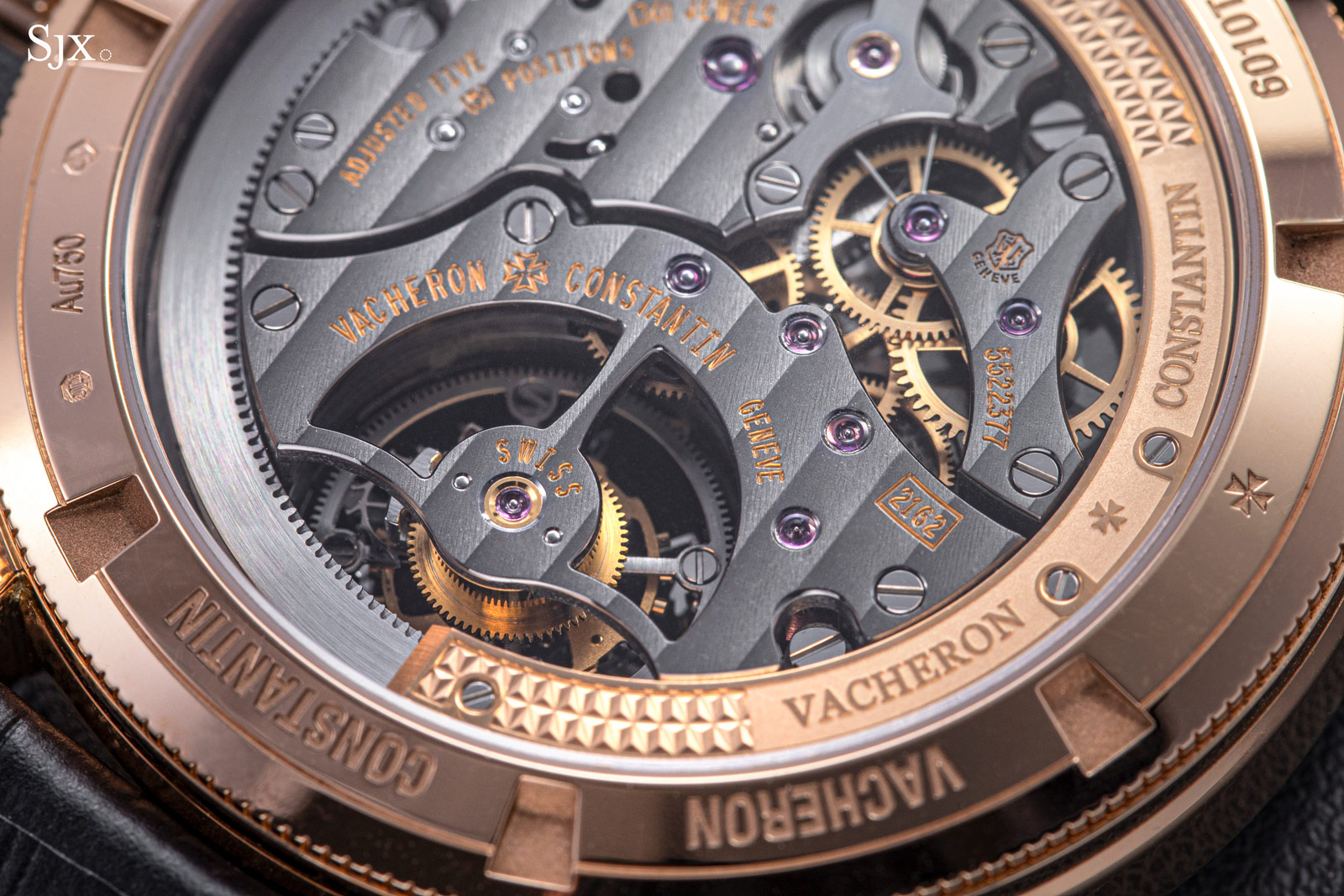
The open dial gives the face a three-dimensional appearance that is enhanced by details like the raised, rounded arms of the tourbillon bridge and the “floating” hour markers that sit on the clear sapphire dial. This results in a modern aesthetic that stands apart from most of VC’s offerings, yet remains recognisable thanks to certain design elements shared with other Traditionnelle models.
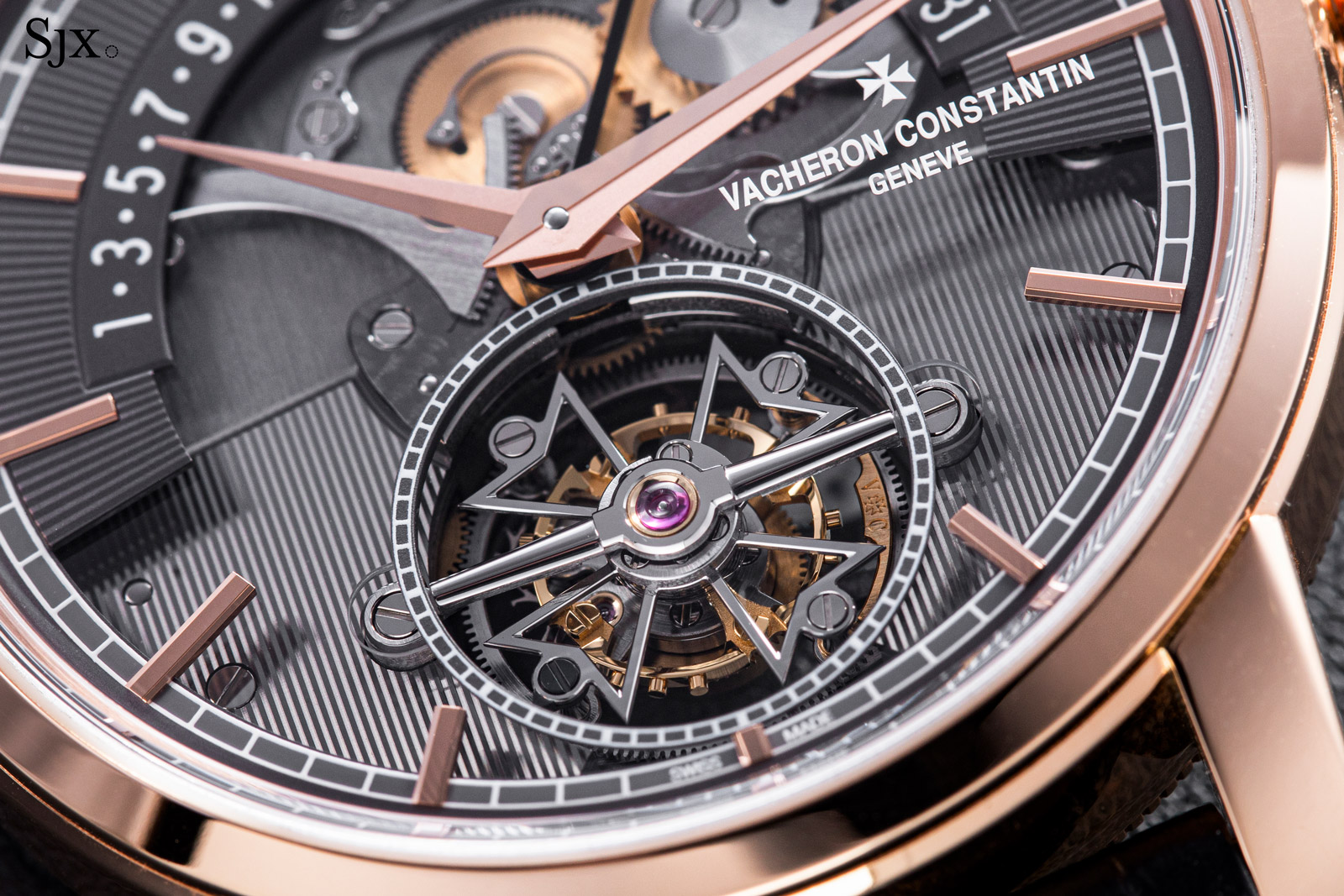
If there’s one thing about the watch I would change, it’s the case thickness. At just over 11 mm high the case is not thick, but it feels taller than an elegant watch should be. The 41 mm diameter is same as most Traditionnelle models for men, but it’s taller than most other models in the range.
This would have a more elegant profile if it retained the same 41 mm diameter, but with a height of 10 mm or so (like the Overseas Tourbillon with the same movement but sans date). That said, the reason for the height is the multi-layer dial and retrograde date so the case can’t be any thinner. The Traditionnelle Tourbillon without a date is identical in diameter but 1 mm slimmer.
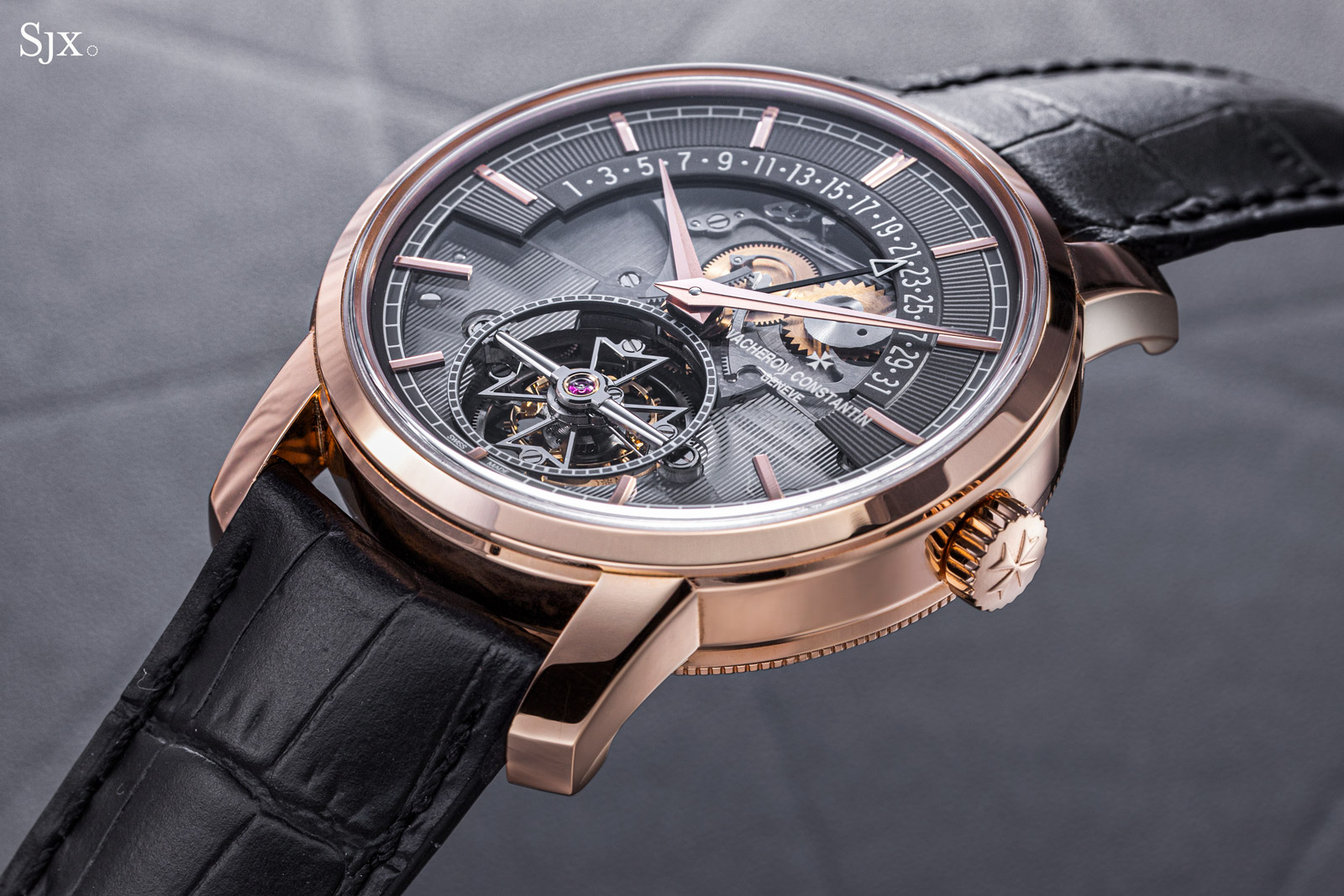
Graceful jumping
The Tourbillon Retrograde Date retains all of the defining elements of the Traditionnelle. Even though each is subtle in itself, together they give it a distinctive look. Amongst them are the lugs inspired by the arms of the Maltese cross, a fluted rim on the back, and dauphine hands.
Although the Traditionnelle line includes another open-faced model, the this has a more original and appealing look thanks to its symmetry, depth, and visible mechanics.
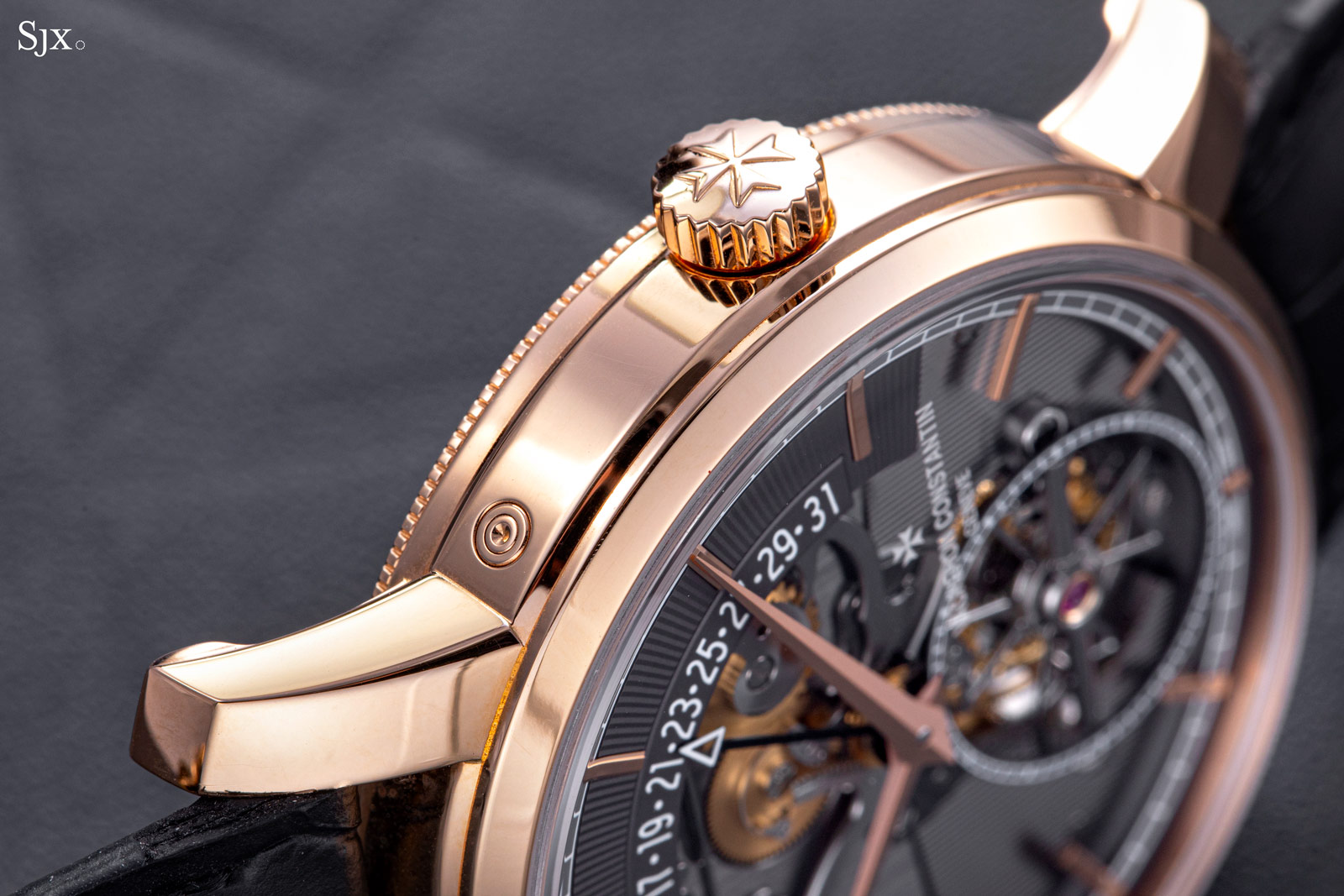
The Traditionnelle Tourbillon manages to be almost symmetrical on the front, which indicates the thought put into the construction of the retrograde date.
A retrograde display does not easily lend itself to symmetry, but the constructors of the movement managed to achieve visual balance by arranging the racks in opposing positions on each side of the hands. The retrograde mechanism as a whole, in turn, serves as a visual counterweight for the tourbillon below. The result is a dial design that has a pleasing equilibrium.
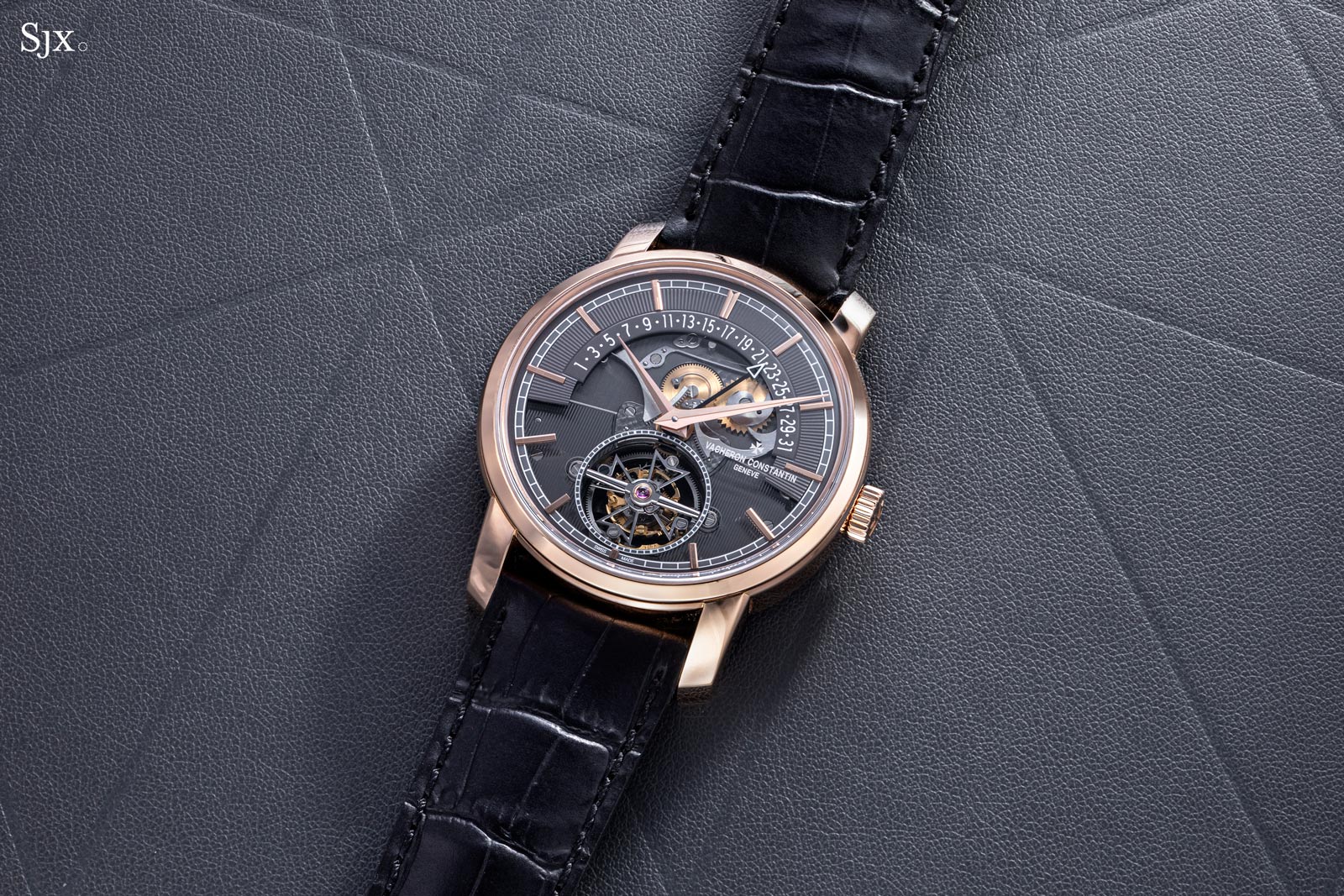
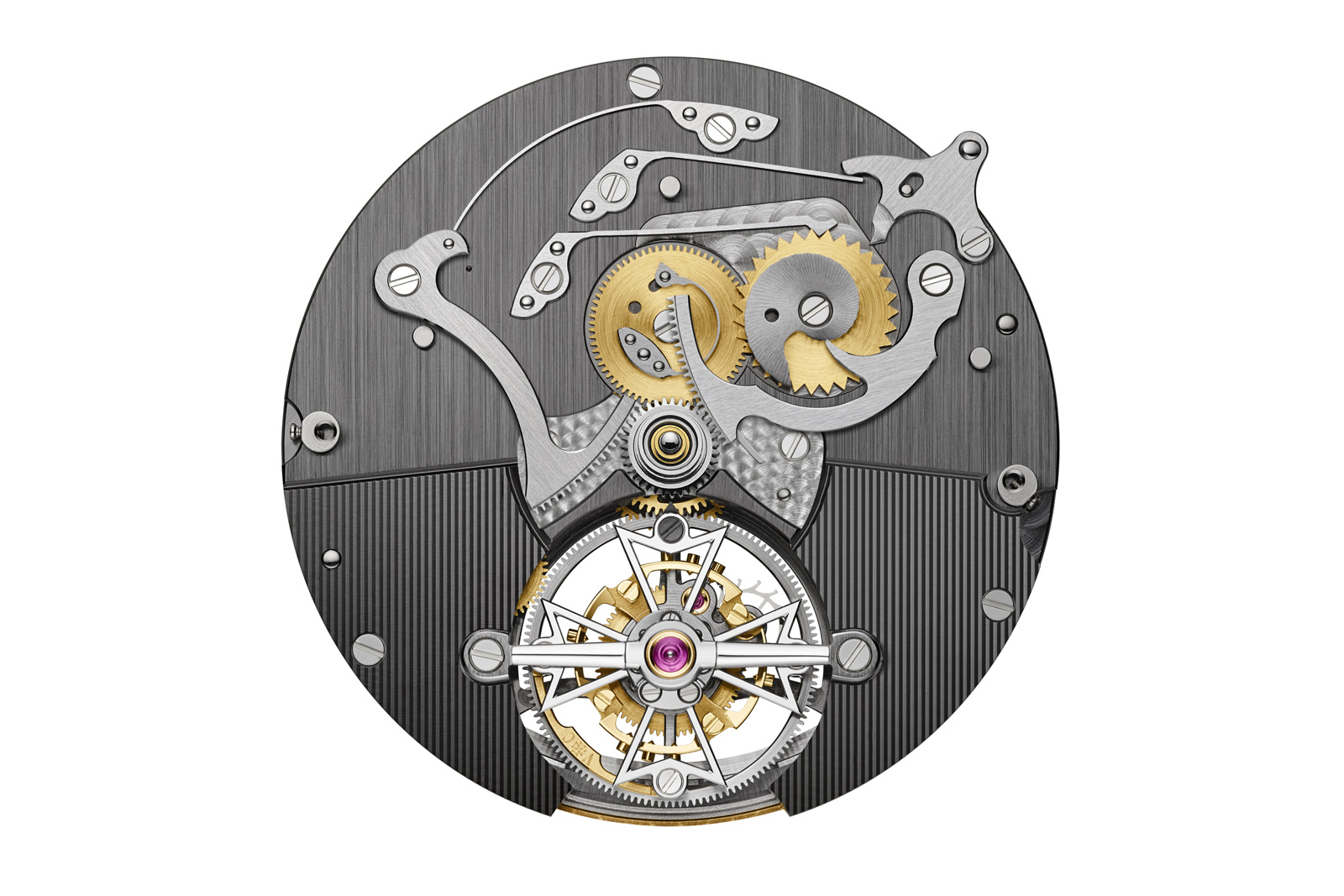
The movement without the dial, showing the retrograde mechanism in its entirety. It also reveals the base plate is a single piece but only the lower half is finished with guilloche. Image – Vacheron Constantin
The visual appeal of the dial is boosted by the guilloche that is radial on the upper chapter ring and vertical on the base plate below. Done the old fashioned way on both surfaces, meaning on a hand-operated straight-line engine, the guilloche gives the dial a contemporary feel despite its traditional nature.
The engine turning on the base plate is particularly unusual, since such decoration is rarely applied to the plate, even on open-faced watches, due in part to the flatness and tolerances required of the part.
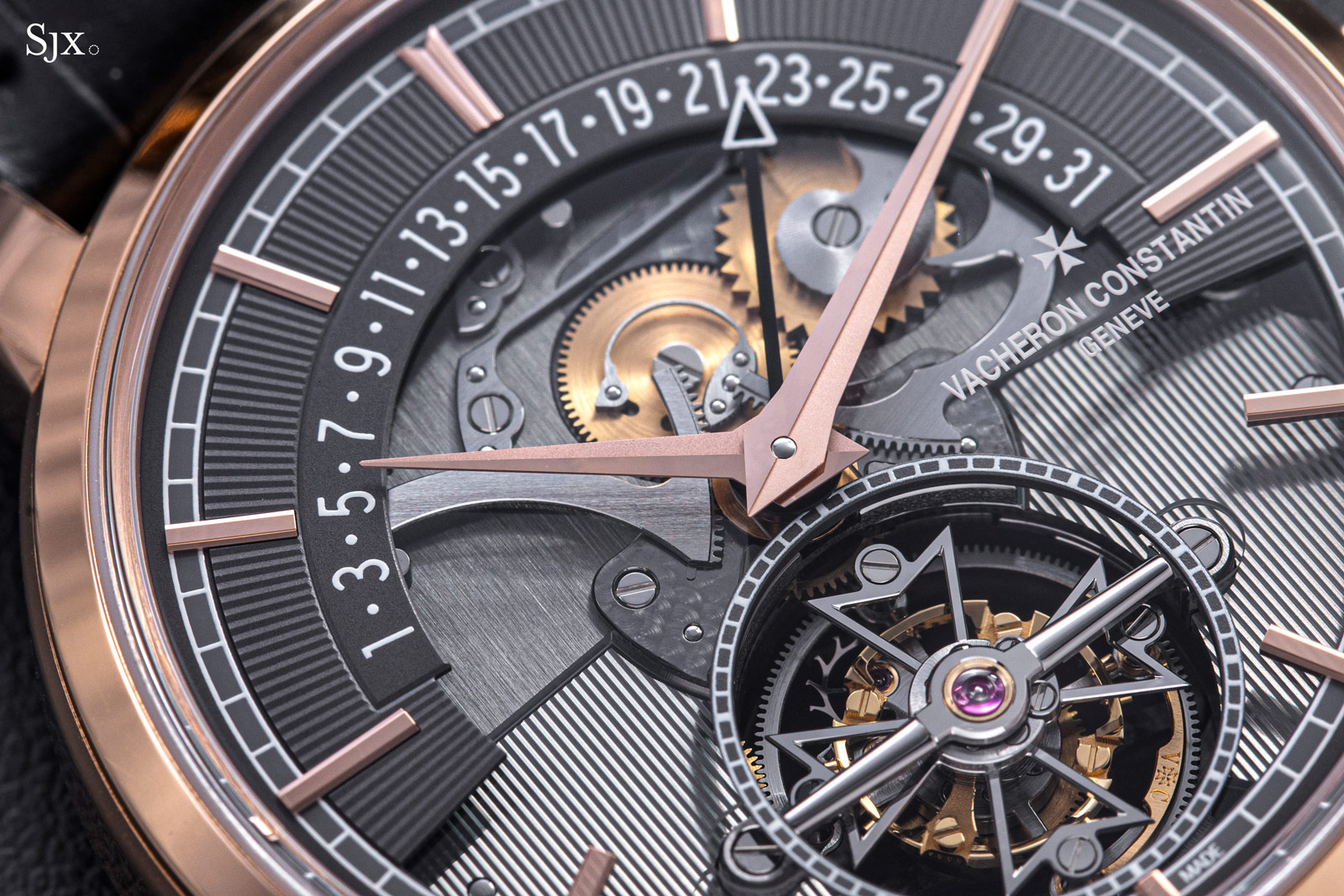
When examined up close the retrograde mechanism reveals itself to be as well finished as it is designed. All the surfaces and edges are decorated appropriately for a watch of this level. Flat surfaces are grained – straight, circular, or spiral – while edges are bevelled, as the slots and edges of the screw heads. Even the heads of the pins securing the tension spring are polished.

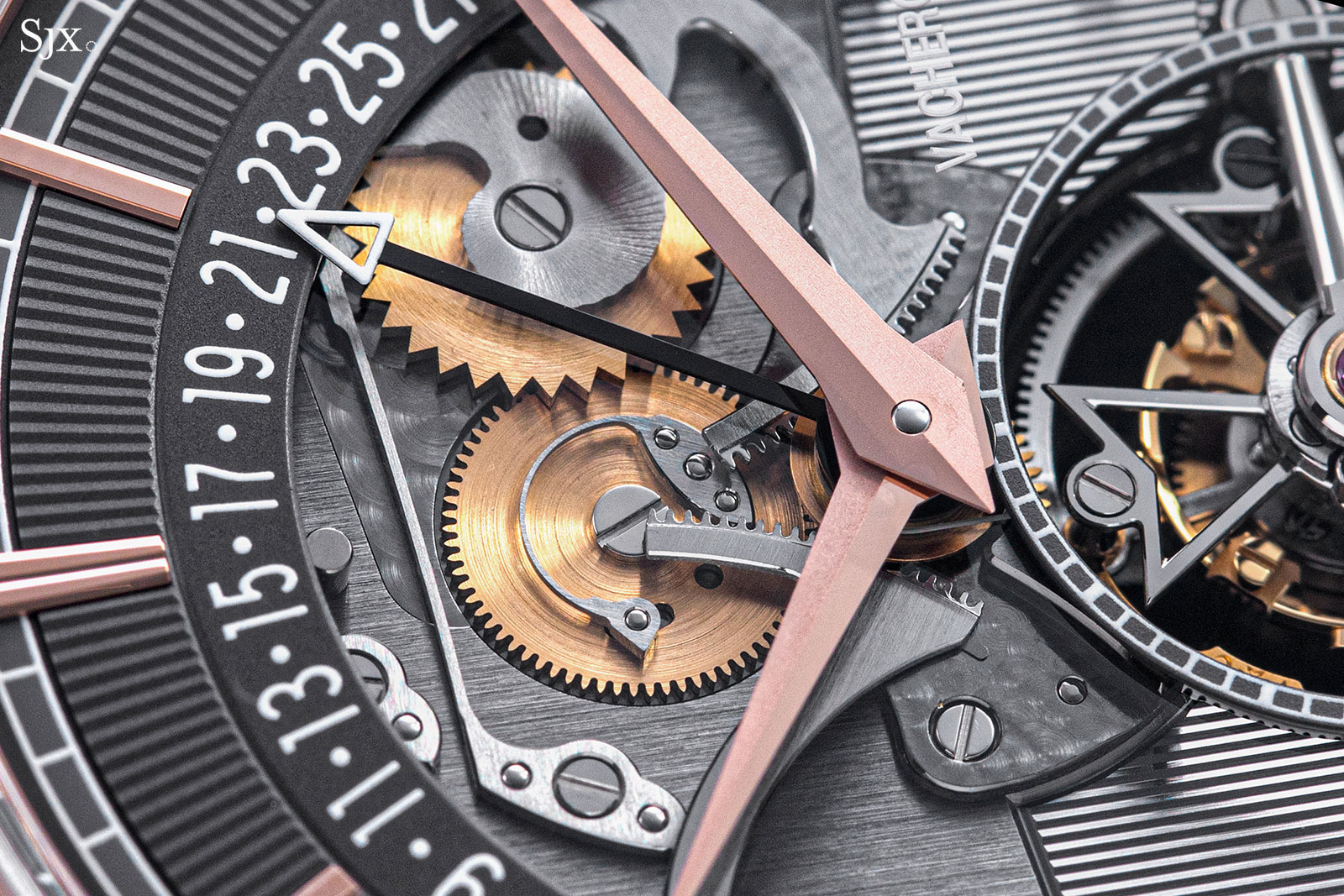
The more familiar section of the dial is the tourbillon, which is identical to that in several other VC tourbillon models. In traditional VC style, the tourbillon cage takes the form of a Maltese cross.
Both the cage and bridge are in black-polished steel and outfitted with the expected high-end detailing, including sharp angles, inward and outward, on the cage and rounded arms on the bridge.
One element that doesn’t blend in seamlessly is the seconds track around the tourbillon. It sits on the sapphire dial, which also means it covers each end of the tourbillon bridge. I would have opted to a pair of semicircular half scales so as to leave the tourbillon bridge complete visible.
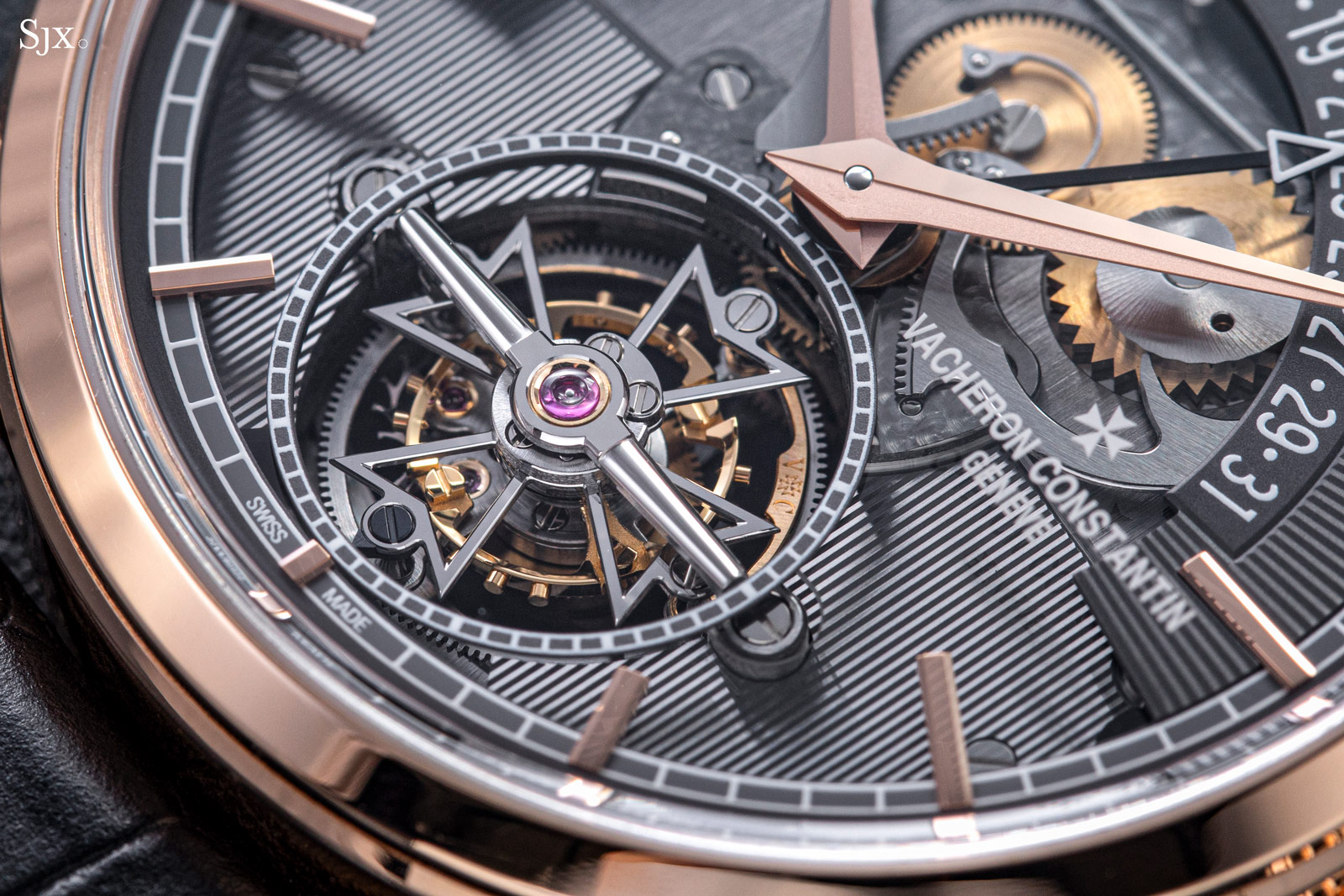
One of the four screws on the cage is black coated so it doubles as the seconds indicator
Weighted on the perimeter
The Tourbillon Retrograde Date is powered by the cal. 2162 R31, which is based on the cal. 2160 found in a variety of models, from the FiftySix to the Overseas, but with the base plate modified to accommodate the retrograde date.
The clever bit of the movement is its peripheral winding – a semicircular rotor of 22k gold sits on a large winding wheel with teeth on its inner rim that engages with the winding train. Peripheral winding first arrived on the market in the late 1960s as a cutting edge winding system, amongst its proponents then was Patek Philippe. But early versions of the mechanism were neither effective nor reliable, and the idea died out in the 1980s.
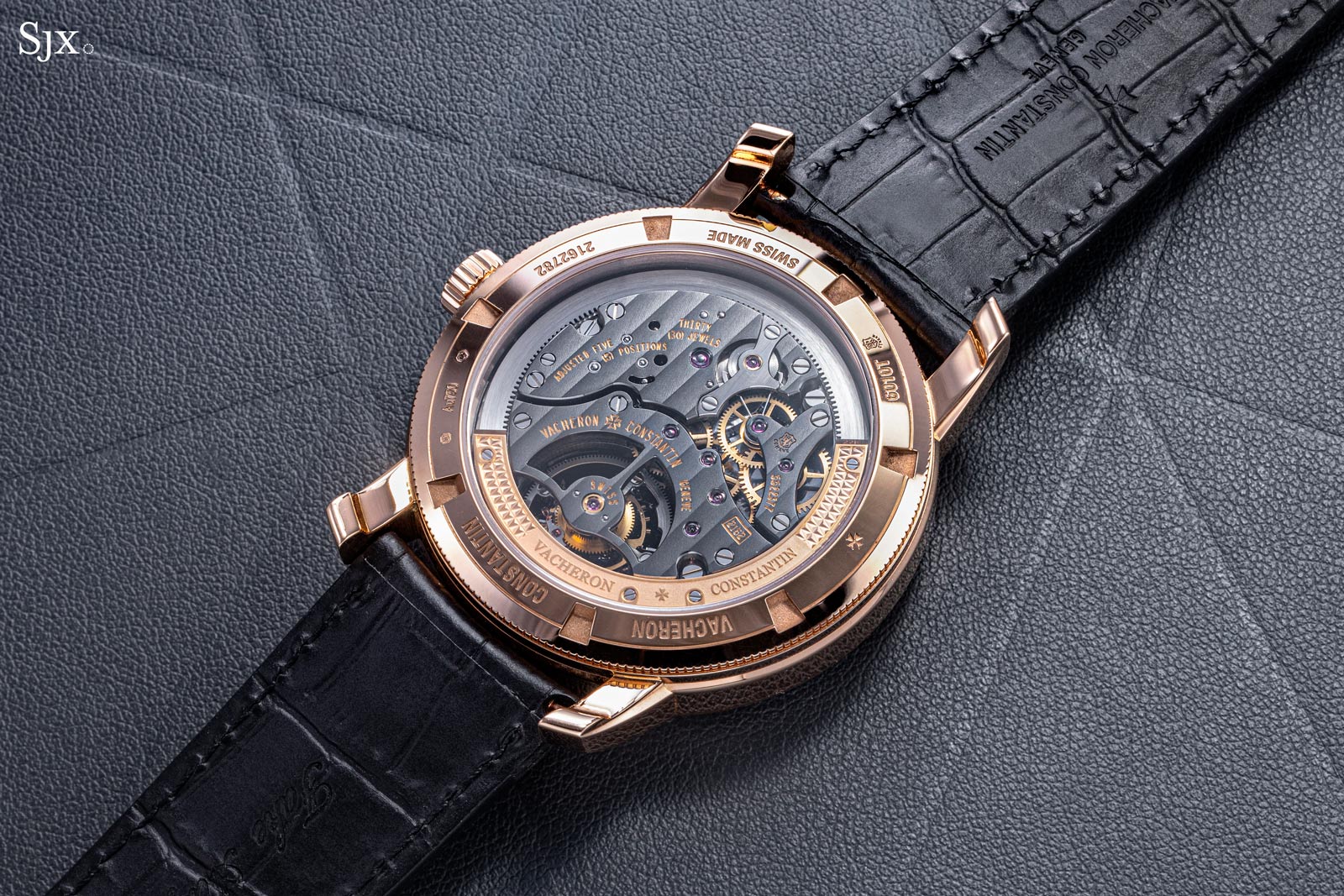
But as with many old ideas in watchmaking, abandoned concepts are dusted off once technology makes them feasible and peripheral winding made a comeback in 2008 with Carl F. Bucherer. Now it’s found in movements of several brands, with VC having installed peripheral winding in several of its movements, including the exquisite cal. 3500 of the Traditionnelle Split-Seconds Chronograph.
Peripheral winding has the advantage of both thinness and leaving the entire movement visible, which is especially useful in a high-end calibre like this. Peripheral winding does result in a wider movement, all things being equal, but that’s not a drawback in modern men’s watches that are generally large enough to easily accommodate it.
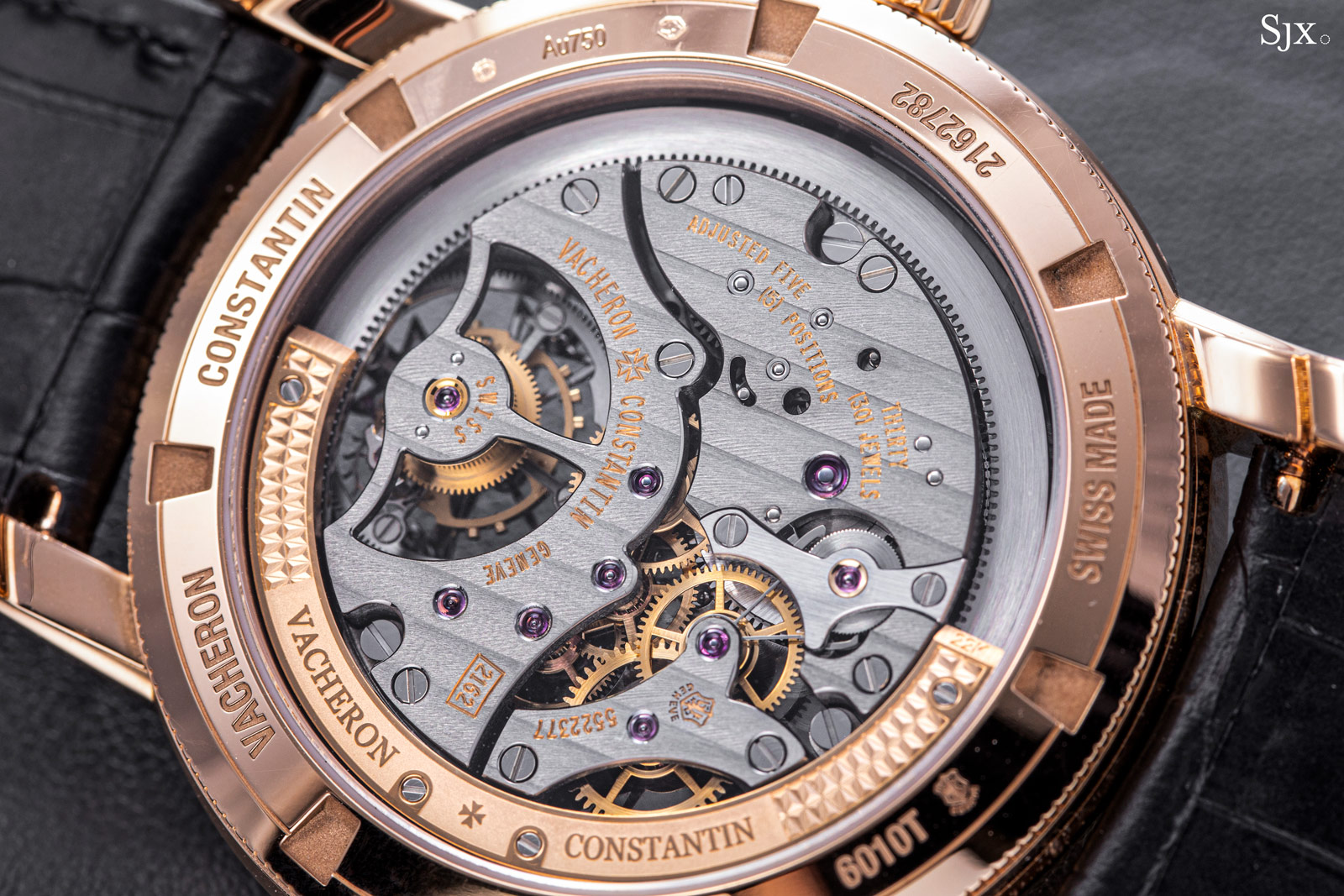
The peripheral rotor engages with the winding train at visible at two o’clock on the back. This in turn connects to a “Magic Lever” winding mechanism that relies on a fork-shaped pawl for bidirectional winding. Invented by Seiko in 1959, the Magic Lever is now popular in both Swiss and Japanese watchmaking for its simple, effective nature and thinness. Although it requires a wider area, the Magic Lever occupies little vertical space, making it well suited for constructions that demand thinness.
Christian Selmoni, VC Style and Heritage Director, summed up the philosophy behind the movement at its launch in 2018, “[The Magic Lever may be] simpler than solutions found in other Vacheron Constantin calibres, however it offers us an advantage in terms of thickness. As we wanted our new automatic tourbillon caliber 2160 to be implemented in elegant timepieces – so it had to be a thin movement – this height advantage made really sense for us, in addition to the proven reliability of the Magic Lever itself.”
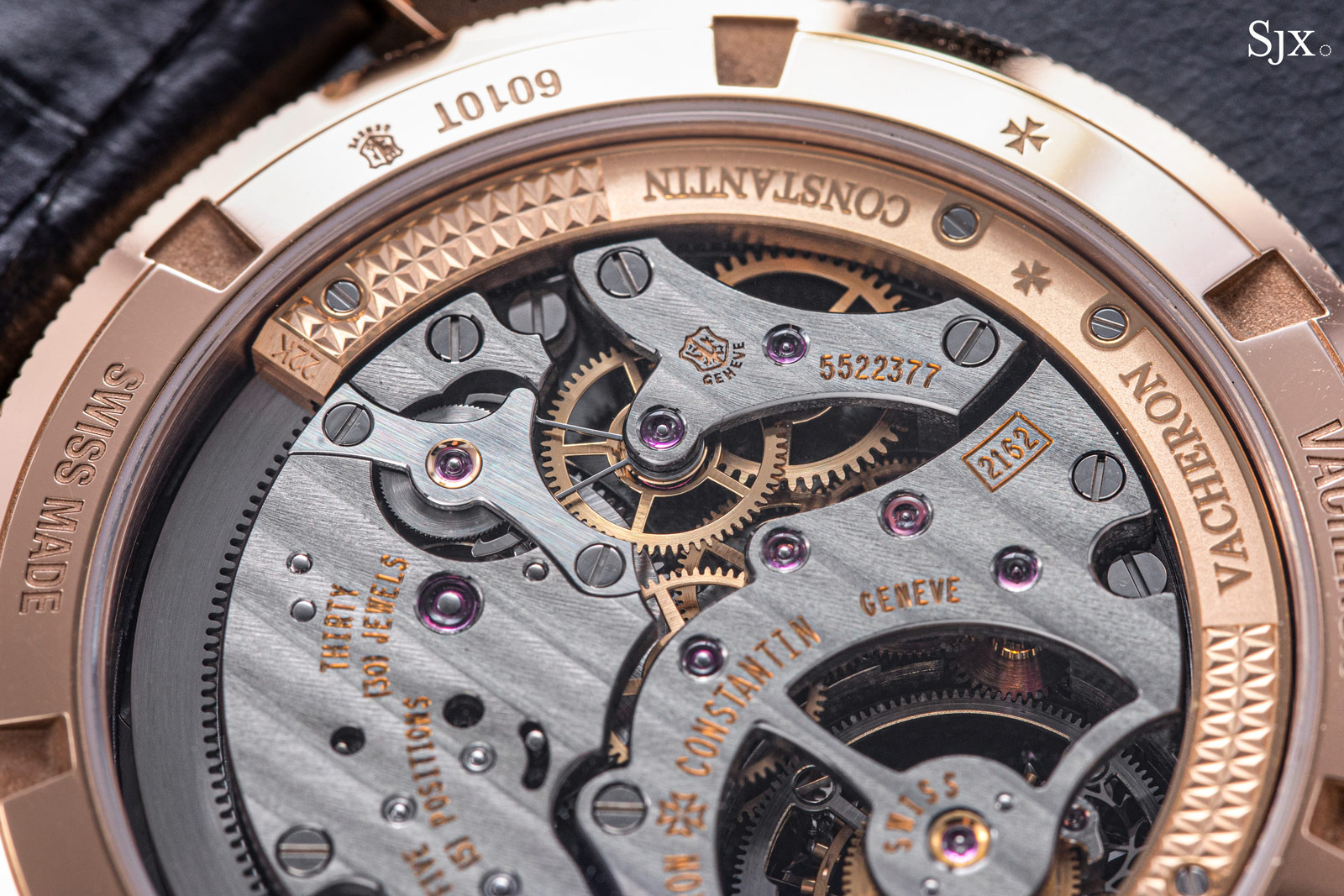
Bearing the Poinçon de Genève as do most mechanical VC movements, the cal. 2162 R31 is decorated to a level typical of such a watch. Every aspect is dealt with correctly, ranging from the bevelled edges of bridges to chamfered spokes on wheels to polished countersinks.
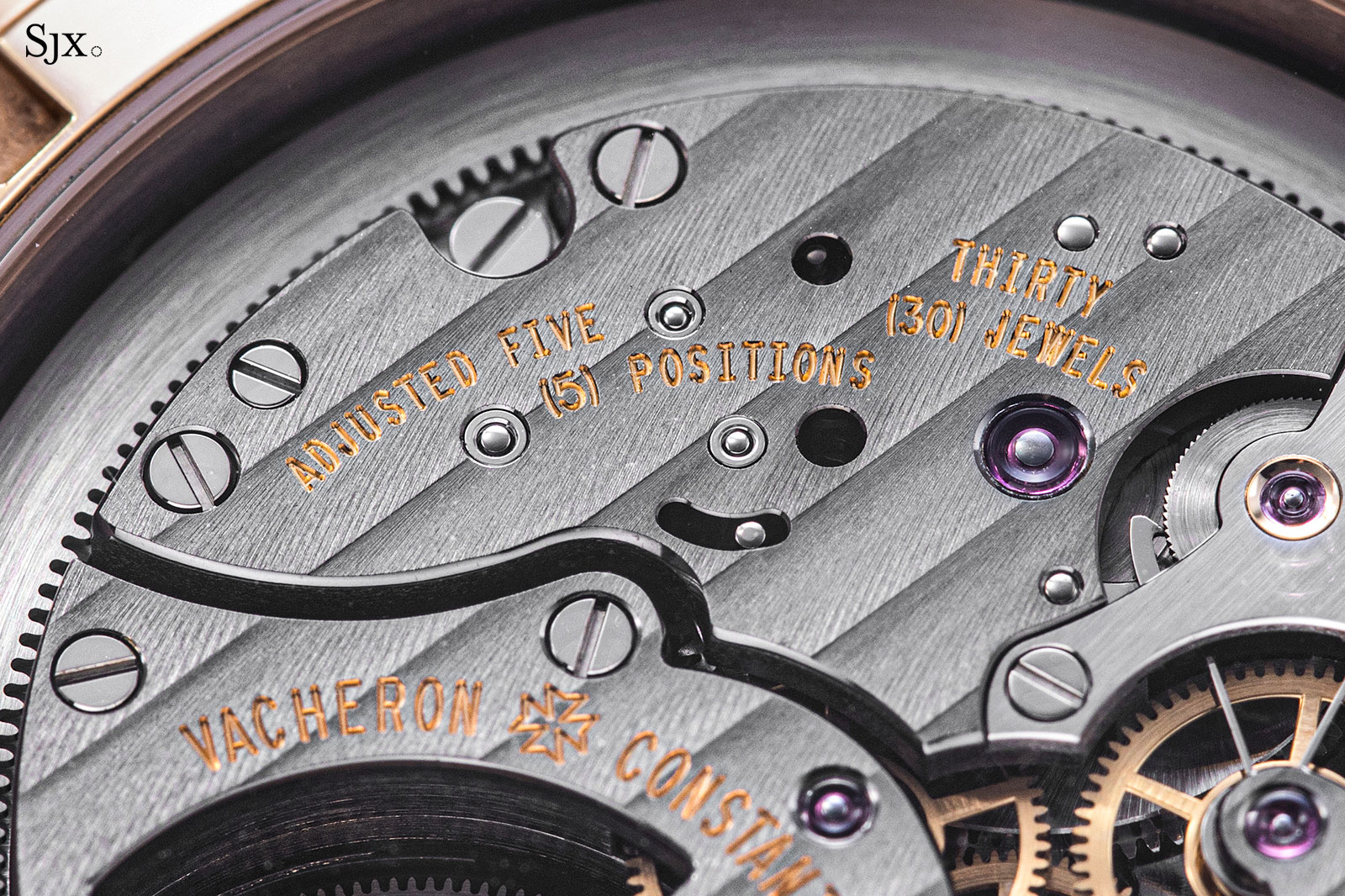
The decoration of the tourbillon assembly visible on the front is done to a slightly more elaborate level than that on the back, which is comparable to similarly-positioned watches from Patek Philippe and Audemars Piguet.
It would have been a bonus to incorporate a few of the decorative flourishes found in the cal. 3500 split-seconds chronograph, but that costs double the Tourbillon Retrograde Date.
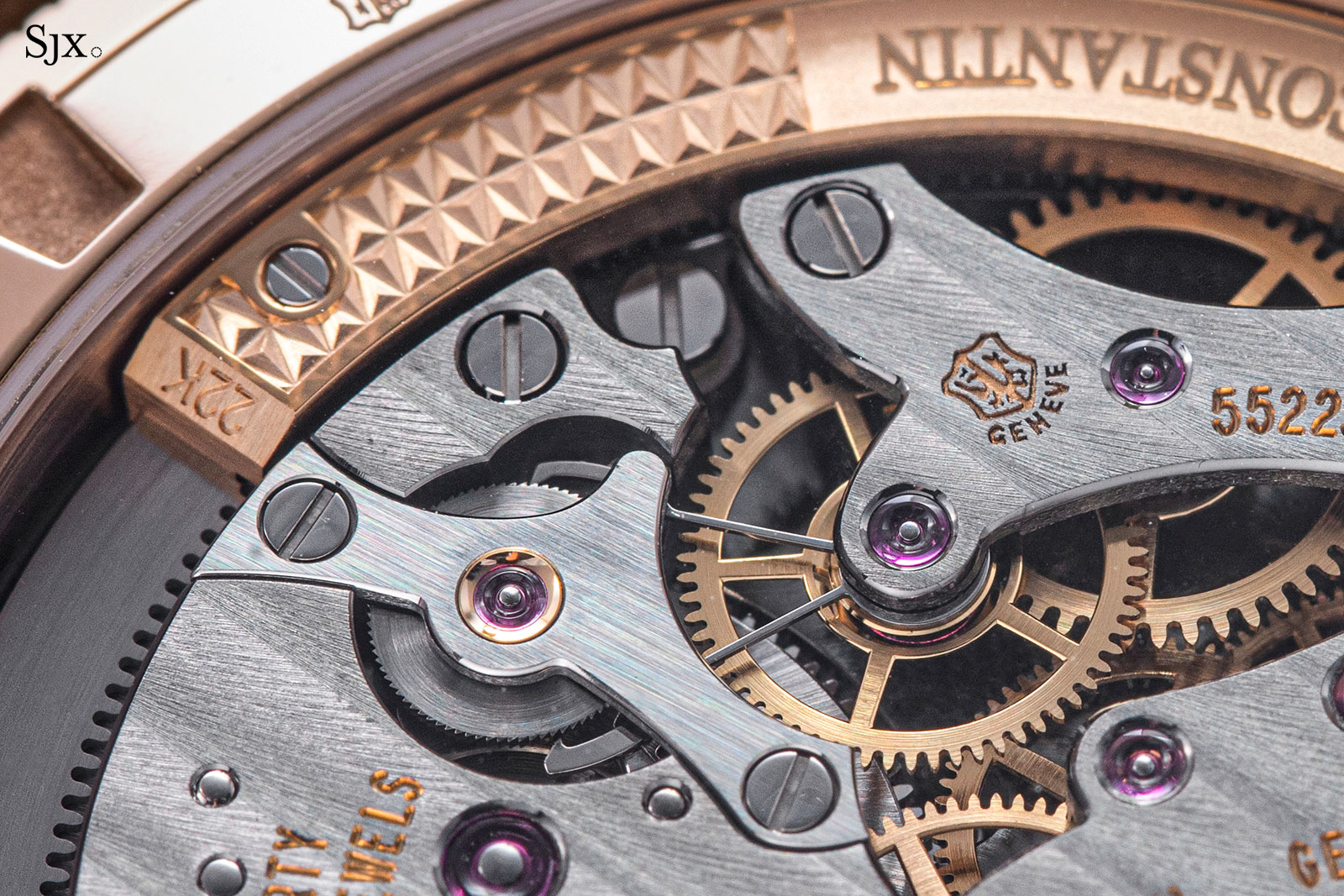
The bridges for the winding train have been reduced in size to reveal the wheels and Magic Lever pawl below
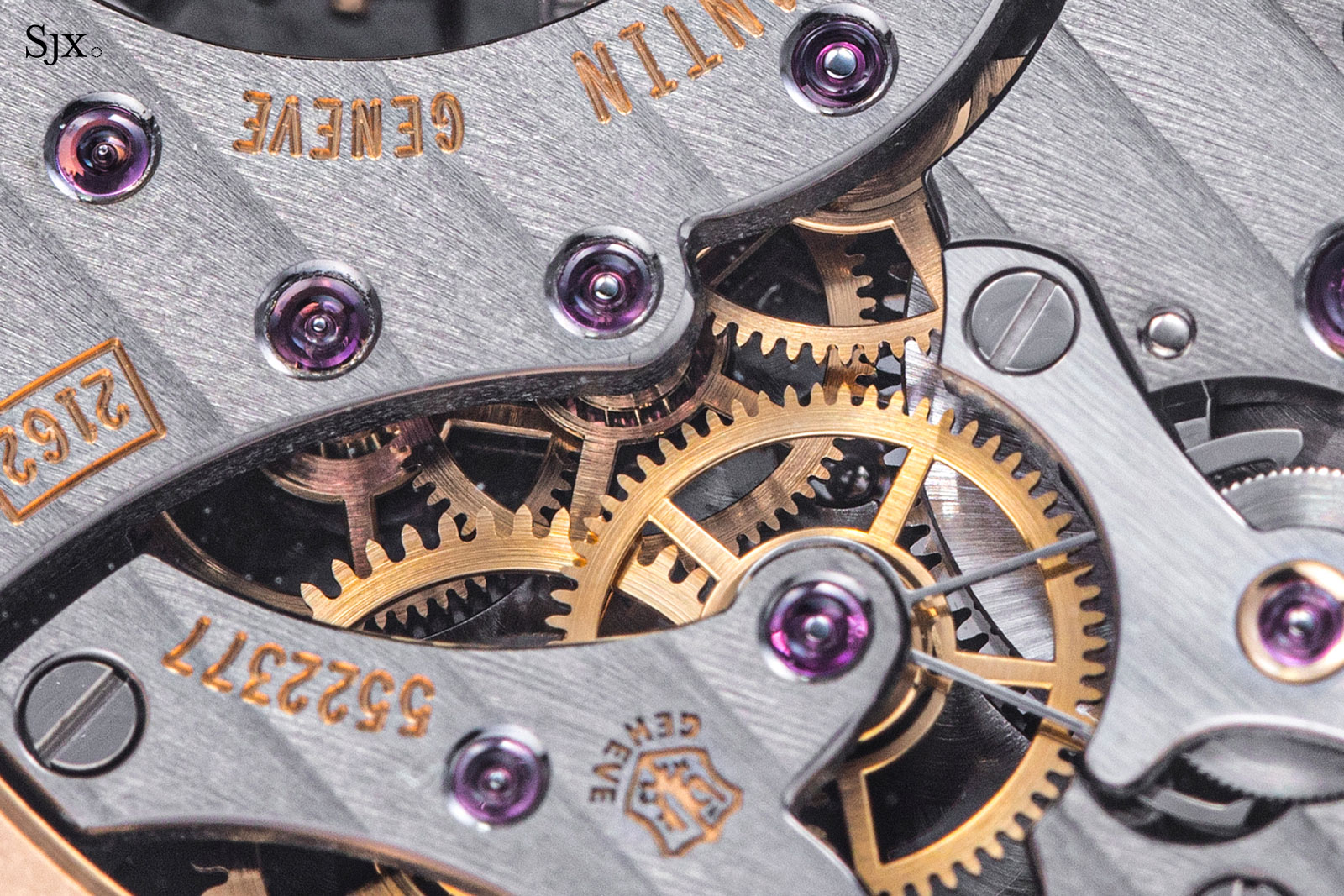
The wheels are finished with circular graining while their inner and spokes are chamfered
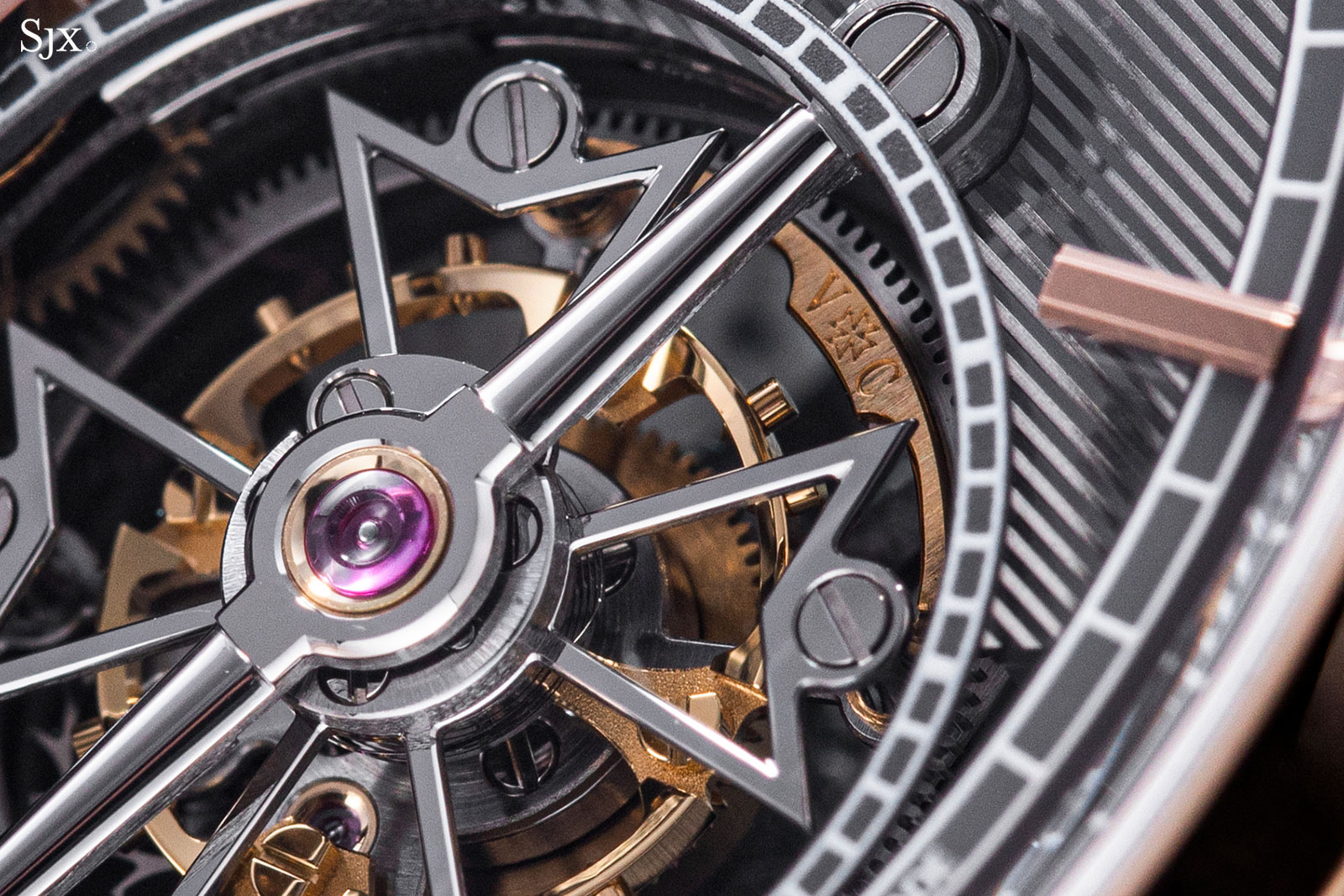
One of the discreet artisanal details in the movement: the “VC” signature hand engraved on the lower cage of the tourbillon
Concluding thoughts
The Tourbillon Retrograde Date demonstrates that even the simplest complication can be a point of appeal if it is executed properly – namely a refined construction and good finishing – and presented on the right background, which in this case is guilloche and perlage. But the watch is compelling because of the coherent integration of all its elements. The sum of the whole is greater than the parts, though I do wish it was a little thinner, or even if was merely perceived as thinner with some design tweaks.
The elaborate nature of the retrograde date also raises the possibility of a similar watch with the date, but no tourbillon – such a watch would have a great deal of appeal at a far more accessible price.
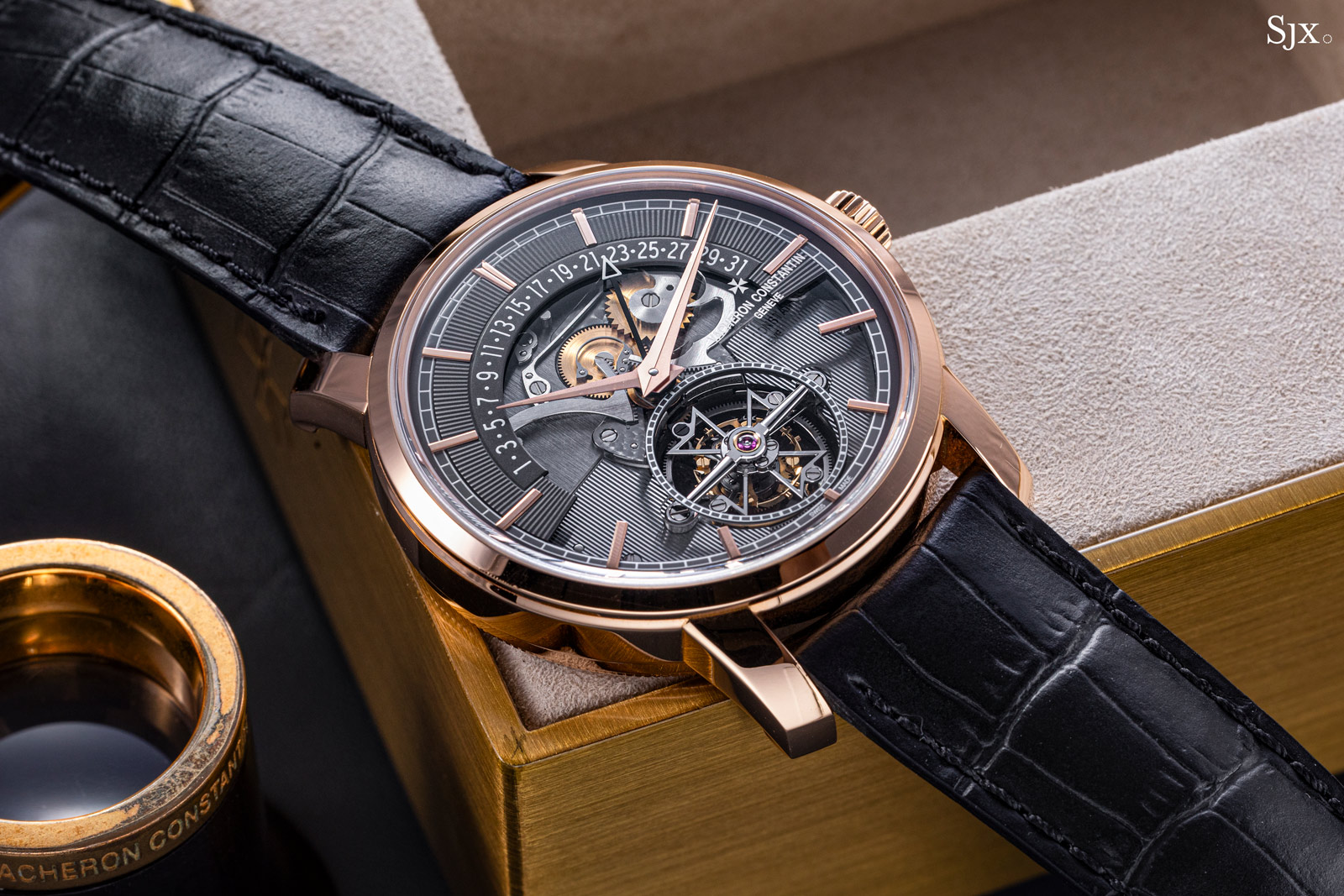
Key facts and price
Vacheron Constantin Traditionnelle Tourbillon Retrograde Date Openface
Ref. 6010T/000R-B638
Diameter: 41 mm
Height: 11.07 mm
Material: 18K 5N pink gold
Crystal: Sapphire
Water resistance: 30 m
Movement: Cal. 2162 R31
Features: Hours, minutes, small seconds on tourbillon cage, tourbillon, and retrograde date
Frequency: 18,000 beats per hour (2.5 Hz)
Winding: Automatic
Power reserve: 72 hours
Strap: Alligator with folding clasp
Limited edition: No
Availability: At Vacheron Constantin boutiques only
Price: €200,000 (subject to change)
For more, visit Vacheron-constantin.com.
Back to top.